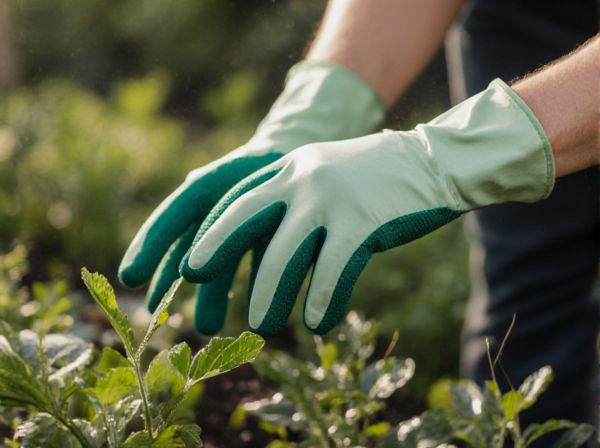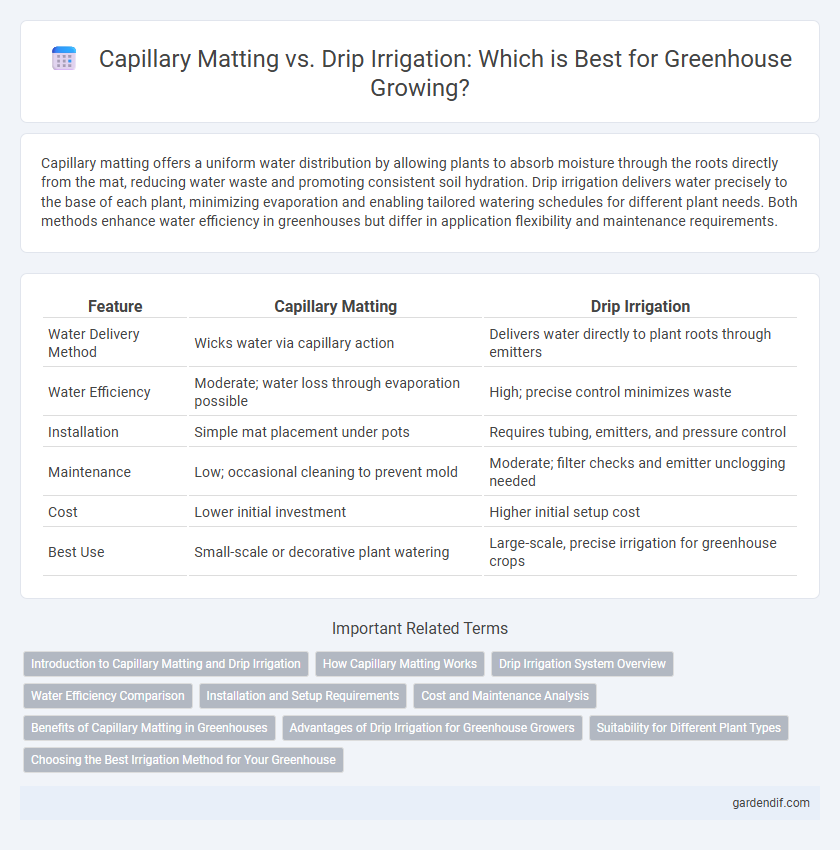
Capillary Matting vs Drip Irrigation Illustration
Capillary matting offers a uniform water distribution by allowing plants to absorb moisture through the roots directly from the mat, reducing water waste and promoting consistent soil hydration. Drip irrigation delivers water precisely to the base of each plant, minimizing evaporation and enabling tailored watering schedules for different plant needs. Both methods enhance water efficiency in greenhouses but differ in application flexibility and maintenance requirements.
Table of Comparison
| Feature | Capillary Matting | Drip Irrigation |
|---|---|---|
| Water Delivery Method | Wicks water via capillary action | Delivers water directly to plant roots through emitters |
| Water Efficiency | Moderate; water loss through evaporation possible | High; precise control minimizes waste |
| Installation | Simple mat placement under pots | Requires tubing, emitters, and pressure control |
| Maintenance | Low; occasional cleaning to prevent mold | Moderate; filter checks and emitter unclogging needed |
| Cost | Lower initial investment | Higher initial setup cost |
| Best Use | Small-scale or decorative plant watering | Large-scale, precise irrigation for greenhouse crops |
Introduction to Capillary Matting and Drip Irrigation
Capillary matting is a highly efficient irrigation system that relies on a porous fabric to distribute water evenly to plant roots, minimizing water wastage and promoting consistent moisture levels. Drip irrigation delivers water directly to the base of each plant through a network of tubes and emitters, allowing for precise control over water application and reducing evaporation losses. Both methods improve water use efficiency in greenhouses but differ in delivery mechanisms and suitability for various plant types.
How Capillary Matting Works
Capillary matting operates by utilizing a porous fabric that draws water from a reservoir through capillary action, providing consistent moisture to plant roots. This system ensures uniform water distribution across the entire mat surface, reducing water waste and promoting efficient root hydration. In greenhouse environments, capillary matting is especially effective for seedlings and potted plants, maintaining optimal soil moisture without the risk of overwatering commonly associated with drip irrigation.
Drip Irrigation System Overview
Drip irrigation systems provide precise water delivery directly to plant roots through a network of tubes, emitters, and valves, optimizing water use efficiency in greenhouses. This system reduces evaporation and runoff compared to capillary matting, making it ideal for controlling moisture levels in varied plant arrangements. Advanced drip irrigation setups incorporate automated timers and moisture sensors, enabling consistent irrigation schedules and promoting healthy plant growth.
Water Efficiency Comparison
Capillary matting delivers water directly to plant roots through a porous fabric, minimizing evaporation and runoff, resulting in up to 90% water efficiency in greenhouse environments. Drip irrigation targets specific plant zones with controlled emitters, achieving water savings of approximately 70-80% compared to traditional watering methods but may experience some losses due to emitter clogging or uneven distribution. Overall, capillary matting offers superior water conservation in controlled greenhouse settings by maintaining consistent moisture levels with minimal waste.
Installation and Setup Requirements
Capillary matting requires a flat, permeable surface and precise placement to ensure uniform water distribution, making installation relatively simple but limited to small or controlled environments. Drip irrigation demands more complex setup, including a network of tubing, emitters, and a water source connection, which allows scalable and targeted watering across diverse greenhouse layouts. Both systems necessitate proper maintenance to prevent clogging and ensure consistent performance, but drip irrigation offers greater flexibility for automation and customization.
Cost and Maintenance Analysis
Capillary matting offers a low-cost irrigation solution with minimal maintenance, relying on passive water distribution that reduces installation expenses and energy usage. Drip irrigation systems, while more expensive initially due to pumps, tubing, and emitters, provide precise water delivery that can lower long-term water costs and reduce plant stress. Maintenance for drip irrigation involves regular emitter checks and filter cleaning, whereas capillary matting requires occasional mat replacement and monitoring for mold or blockages.
Benefits of Capillary Matting in Greenhouses
Capillary matting provides consistent and uniform moisture delivery directly to plant roots, reducing water waste and improving growth efficiency in greenhouses. It minimizes the risk of fungal diseases by keeping foliage dry, unlike drip irrigation which can cause water splashing on leaves. This system also lowers labor costs by simplifying watering schedules and ensuring optimal moisture retention in the growing medium.
Advantages of Drip Irrigation for Greenhouse Growers
Drip irrigation offers precise water delivery directly to the root zone, minimizing water waste and reducing the risk of fungal diseases commonly associated with surface moisture. This method allows greenhouse growers to automate watering schedules, improving efficiency and ensuring consistent moisture levels critical for optimal plant growth. Its scalability and adaptability to various crop types make drip irrigation a superior choice over capillary matting in controlled environment agriculture.
Suitability for Different Plant Types
Capillary matting is ideal for seedlings and moisture-sensitive plants requiring gentle, consistent water delivery, as it evenly distributes water across the surface. Drip irrigation suits larger plants and varieties with deeper root systems, providing precise water targeting at the base to minimize waste and reduce disease risk. Choosing between these methods depends on plant species' water needs and root structure within the greenhouse environment.
Choosing the Best Irrigation Method for Your Greenhouse
Capillary matting offers uniform moisture distribution by wicking water directly to plant roots, reducing water waste and the risk of overwatering in greenhouse environments. Drip irrigation provides precise control over water delivery to individual plants, enabling tailored irrigation schedules for diverse crop needs and maximizing water efficiency. Selecting the best method depends on factors such as crop type, greenhouse size, labor resources, and budget constraints to optimize growth and resource use.
Capillary Matting vs Drip Irrigation Infographic

 gardendif.com
gardendif.com